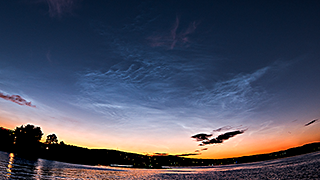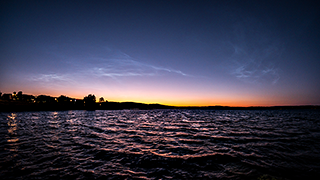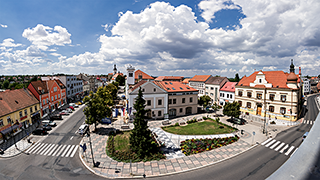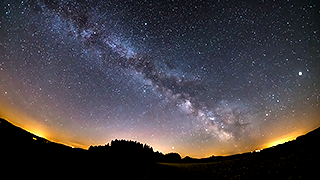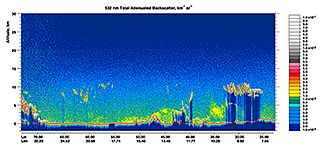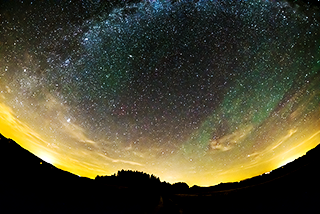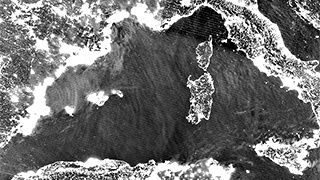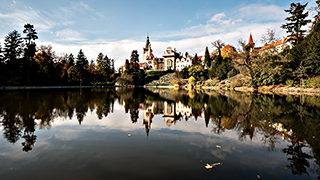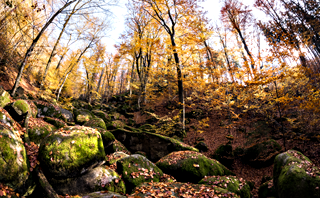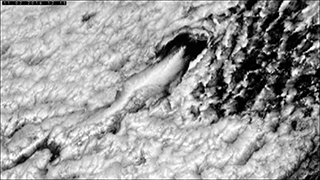
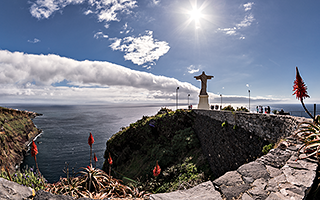
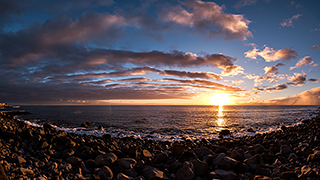
|
In the wake of
Madeira, 2018-02-11
Cloud wakes forming downwind of isolated islands (such as Madeira) or
groups of islands (e.g. Canary Islands) are rather a common feature in
many parts of the world. These cloud wakes can have a form of a simple
cloud-free "gap" in the clouds, sometimes (as in this case) the gap can
be partially filled by a cloud-plume forming inside the wake and often
propagating upwind, towards the island. In many other cases clouds in
the wake can form a series of smaller eddies, forming close to the
island, which grow as they propagate downwind, away from the island
(called Kármán vortex street, or just simply Kármán
vortices).
This case shows an example of such a cloud wake (the simple form), as
documented by Meteosat-9 satellite, and also as captured from ground,
in two timelapse series.
08:00 - 19:00 UTC, Meteosat-9 (MSG-2) SEVIRI
HRV band, interval 5 minutes, speed 7500x
20180211_0800-1900utc_Madeira_Meteosat-9_HRV-RSS.mp4
See also the stand-alone HRV images taken at 12:15 UTC
and 18:30
UTC,
at times matching the two timelapse movies below. The red dots in these
indicate locations from which the two timelapse movies below were taken.
11:52 - 12:42 UTC (0h 50m), Garajau
Samsung NX 500 & Samyang 8mm F2.8 UMC Fisheye II, interval 2
seconds, speed 60x
20180211_1152-1242utc_Madeira_Garajau_1728x1080.mp4
(101 MB)
This timelapse sequence shows
the eastern edge of the cloud wake, as taken from Garajau at the
south-east coast of Madeira, 12:15 UTC,
southward view. By this time, the eastern edge wasn't anymore as
compact as earlier morning, and the "edge" had rather a wave-like
structure. Some of the waves seemed to be rotating along their
horizontal axis, as can be seen in later part of this sequence.
18:40 - 19:30 UTC (0h 50m), Paul do Mar
Samsung NX 500 & Samyang 8mm F2.8 UMC Fisheye II, interval 2
seconds, speed 60x
20180211_1840-1930utc_Madeira_Paul-do-Mar_1920x1080.mp4 (106
MB)
In this sunset to dusk timelapse
sequence, taken from Paul do Mar at the south-west coast of Madeira (18:30 UTC,
westward view), the camera captured cloud waves forming along the
coast, roughly perpendicular to the western edge of the wake. The
(partially precipitating) western edge itself can be seen at right part
of these frames, just above the sea level.
|
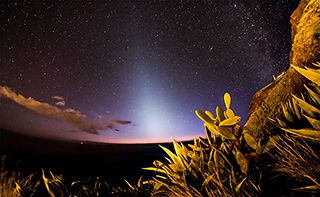
|
Zodiacal light from
Madeira, 2018-02-12, 19:35 - 22:50 UTC (3h 15m)
Samsung NX 500 & Samyang 8mm F2.8 UMC Fisheye II, interval 20
seconds, speed 600x
ISO 3200, exposure 15 seconds, F/2.8
When planning our vacation at
Madeira (when to go and where to stay), I was taking into account my
desire to see and to timelapse dark nocturnal sky, in the evenings
variegated by the Zodiacal light. Since I knew that Madeira is rather
suffering from heavy light pollution,
namely at the southern coast, we were looking for a site which is not
light-polluted as much as the rest of the coast. In the end, we decided
to stay at Paul do Mar, a small town at south-west coast of the island
(in this image indicated by a red dot on the coast).
20180212_1935-2250utc_Madeira_Paul-do-Mar_1760x1080.mp4
(44 MB)
This timelapse movie was taken
from a
cliff some 150 m above Paul do Mar, where I was hoping to find somewhat
darker conditions, escaping from the worst, the street lights. Though
the sky above was more or less sufficiently dark, the lights
of the town
were still bright enough to illuminate the surroundings (and cast my
shadow on the nearby vegetation, while irregularly checking my camera).
In the end, the illuminated cliffs, vegetation and clouds contributed
nicely to the overall impression of this timelapse movie.
|
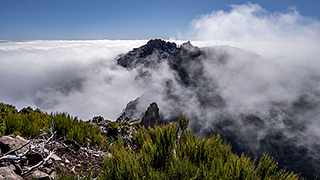 |
Above clouds of
Madeira, 2018-02-15, 12:05 - 13:05 UTC (1h 00m)
Samsung NX500 + Samyang 12mm, interval 4 seconds, speed 120x
20180215_1205-1305utc_Madeira_Pico-Ruivo_1920x1080.mp4
(64 MB)
"Ocean of clouds" captured from
Pico Ruivo
(1862 m), highest mountain of Madeira, Portugal. The peaks in
center of the frame are Pico das Torres (1851 m, the closer one)
and Pico do Areiro (1818 m, the farther one).
|
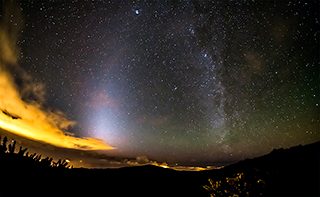 |
Zodiacal light from
Madeira, 2018-02-15, 20:25 - 21:00 UTC (0h 35m)
Samsung NX 500 & Samyang 8mm F2.8 UMC Fisheye II, interval 20
seconds, speed 500x
ISO 3200, exposure 15 seconds, F/2.8
20180215_2025-2100utc_Madeira_ER105_1760x1080.mp4
(14 MB)
Despite the nice timelapse from
the
cliffs, I was still hoping for at least one clear night we could spend
timelapsing from a location somewhere higher in the mountains. In the
end, we managed to take this very short timelapse sequence of the
Zodiacal light from an altitude of about 1300m (in this
image
indicated by a red dot inland). Unfortunately, the weather was
unmerciful and has hidden the spectacular Zodiacal light (reaching some
70° high above the local horizon) by a thick layer of clouds. Besides
the Zodiacal light, you may also notice the greenish airglow
(nightglow), spreading from Zodiacal light to the right, lower in the
sky. This nightglow can also be clearly seen in the Suomi-NPP VIIRS Day/Night Band image, as a much brighter
featureless area over the NW Africa and SW Europe.
|






